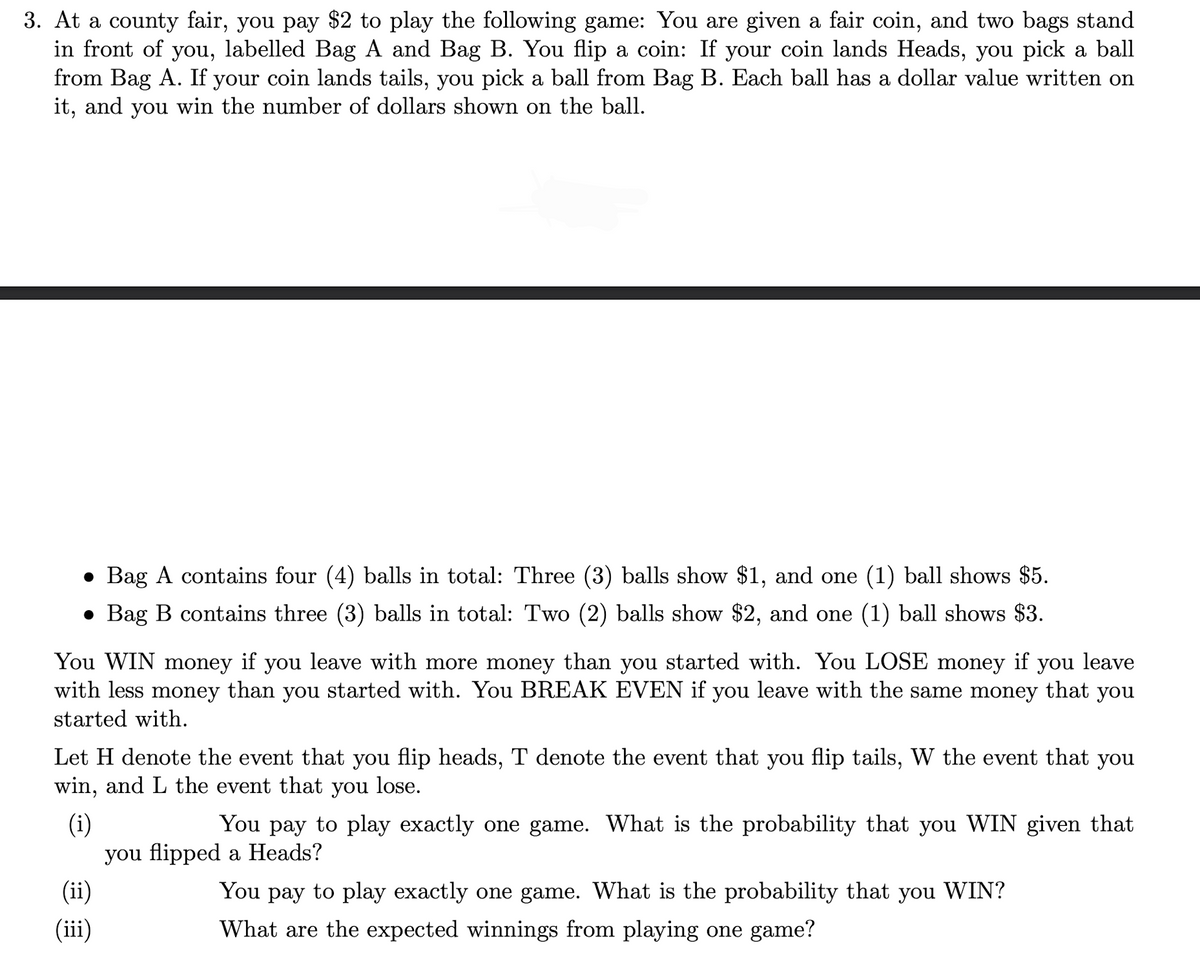3. At a county fair, you pay $2 to play the following game: You are given a fair coin, and two bags stand in front of you, labelled Bag A and Bag B. You flip a coin: If your coin lands Heads, you pick a ball from Bag A. If your coin lands tails, you pick a ball from Bag B. Each ball has a dollar value written on it, and you win the number of dollars shown on the ball. Bag A contains four (4) balls in total: Three (3) balls show $1, and one (1) ball shows $5. • Bag B contains three (3) balls in total: Two (2) balls show $2, and one (1) ball shows $3. You WIN money if you leave with more money than you started with. You LOSE money if you leave with less money than you started with. You BREAK EVEN if you leave with the same money that you started with. Let H denote the event that you flip heads, T denote the event that you flip tails, W the event that you win, and L the event that you lose. (i) you flipped a Heads? You pay to play exactly one game. What is the probability that you WIN given that (ii) You pay to play exactly one game. What is the probability that you WIN? (iii) What are the expected winnings from playing one game?
3. At a county fair, you pay $2 to play the following game: You are given a fair coin, and two bags stand in front of you, labelled Bag A and Bag B. You flip a coin: If your coin lands Heads, you pick a ball from Bag A. If your coin lands tails, you pick a ball from Bag B. Each ball has a dollar value written on it, and you win the number of dollars shown on the ball. Bag A contains four (4) balls in total: Three (3) balls show $1, and one (1) ball shows $5. • Bag B contains three (3) balls in total: Two (2) balls show $2, and one (1) ball shows $3. You WIN money if you leave with more money than you started with. You LOSE money if you leave with less money than you started with. You BREAK EVEN if you leave with the same money that you started with. Let H denote the event that you flip heads, T denote the event that you flip tails, W the event that you win, and L the event that you lose. (i) you flipped a Heads? You pay to play exactly one game. What is the probability that you WIN given that (ii) You pay to play exactly one game. What is the probability that you WIN? (iii) What are the expected winnings from playing one game?
Chapter8: Sequences, Series,and Probability
Section8.6: Counting Principles
Problem 74E: Lottery Powerball is a lottery game that is operated by the Multi-State Lottery Association and is...
Related questions
Question
Hi, please help me with this question and please be specific with your solution
Thanks a lot

Transcribed Image Text:3. At a county fair, you pay $2 to play the following game: You are given a fair coin, and two bags stand
in front of you, labelled Bag A and Bag B. You flip a coin: If your coin lands Heads, you pick a ball
from Bag A. If your coin lands tails, you pick a ball from Bag B. Each ball has a dollar value written on
it, and you win the number of dollars shown on the ball.
• Bag A contains four (4) balls in total: Three (3) balls show $1, and one (1) ball shows $5.
• Bag B contains three (3) balls in total: Two (2) balls show $2, and one (1) ball shows $3.
You WIN money if you leave with more money than you started with. You LOSE money
with less money than you started with. You BREAK EVEN if you leave with the same money that you
if
you leave
started with.
Let H denote the event that you flip heads, T denote the event that you flip tails, W the event that you
win, and L the event that you lose.
You pay to play exactly one game. What is the probability that you WIN given that
(i)
you flipped a Heads?
(ii)
You pay to play exactly one game. What is the probability that you WIN?
(ii)
What are the expected winnings from playing one game?
Expert Solution
This question has been solved!
Explore an expertly crafted, step-by-step solution for a thorough understanding of key concepts.
Step by step
Solved in 2 steps with 2 images

Recommended textbooks for you



